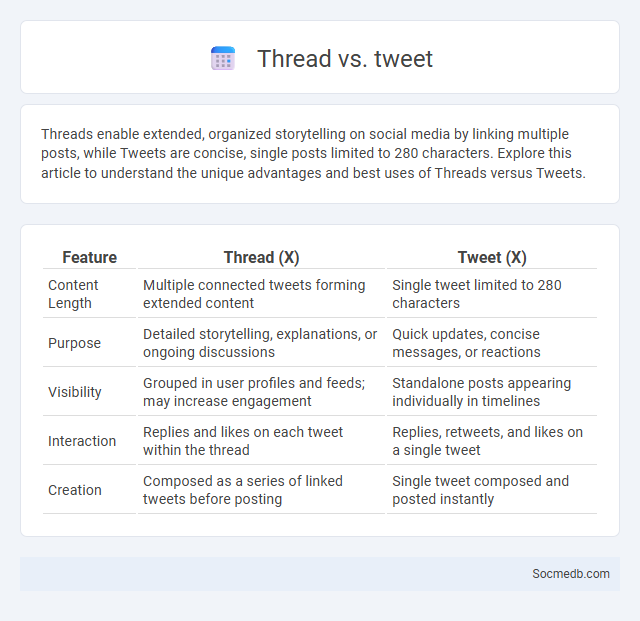
Photo illustration: Thread vs Tweet
Threads enable extended, organized storytelling on social media by linking multiple posts, while Tweets are concise, single posts limited to 280 characters. Explore this article to understand the unique advantages and best uses of Threads versus Tweets.
Table of Comparison
| Feature | Thread (X) | Tweet (X) |
|---|---|---|
| Content Length | Multiple connected tweets forming extended content | Single tweet limited to 280 characters |
| Purpose | Detailed storytelling, explanations, or ongoing discussions | Quick updates, concise messages, or reactions |
| Visibility | Grouped in user profiles and feeds; may increase engagement | Standalone posts appearing individually in timelines |
| Interaction | Replies and likes on each tweet within the thread | Replies, retweets, and likes on a single tweet |
| Creation | Composed as a series of linked tweets before posting | Single tweet composed and posted instantly |
Understanding Threads and Tweets: Core Differences
Threads on social media consist of a series of connected posts that provide detailed narratives or elaborate on complex topics, enabling users to share extended content beyond character limits. Tweets are concise, standalone messages limited to 280 characters, designed for quick updates, opinions, or interactions. Understanding the core differences between threads and tweets helps optimize content engagement by tailoring communication to message length and audience interaction preferences.
What is a Tweet? Key Features Explained
A Tweet is a short message posted on Twitter, limited to 280 characters, designed for quick and concise communication. Key features include hashtags to categorize content, mentions to engage other users, and the ability to attach media like images, videos, or polls to enhance interaction. Tweets can be retweeted, liked, and replied to, facilitating real-time conversations and widespread content sharing across the platform.
Exploring Threads: Definition and Usage
Threads on social media are structured conversations where users can post a main message followed by multiple replies, creating a clear and organized flow of discussion. They enhance user engagement by allowing detailed exchanges on specific topics, making them ideal for in-depth debates or collaborative storytelling. Popular platforms like Twitter, Reddit, and Facebook utilize threads to help users easily follow and contribute to ongoing conversations.
Thread vs Tweet: When to Use Each
Threads are ideal for sharing detailed stories, step-by-step guides, or in-depth analyses that require multiple interconnected tweets for clarity. Tweets work best for concise updates, quick reactions, or sharing single thoughts that engage followers immediately. Choosing between a Thread and a Tweet depends on the content's complexity and the desired level of audience interaction.
Advantages of Posting Threads
Posting threads on social media enhances content organization by allowing users to present complex ideas in a structured and easily digestible format. Threads increase user engagement through sustained interaction and foster deeper conversations by encouraging followers to read and respond to multiple connected posts. This format also improves content visibility and discoverability by leveraging multiple entry points within a single topic or narrative.
Disadvantages of Using Threads
Threads on social media can lead to information overload as continuous updates demand constant attention and disrupt productivity. Privacy concerns arise due to the potential for oversharing, increasing vulnerability to data breaches and cyberbullying. Moreover, the fast-paced nature of threads can perpetuate misinformation, making it difficult to verify facts effectively.
Best Practices for Creating Effective Tweets
Craft clear and concise tweets that capture attention within Twitter's character limit, using relevant hashtags and emojis to increase engagement and reach. Incorporate compelling visuals or short videos to enhance your message and encourage interaction from your audience. Ensure your tweets have a strong call-to-action and post consistently during peak hours to maximize visibility and effectiveness for your social media strategy.
How Threads Enhance Storytelling and Engagement
Threads on social media platforms create a seamless narrative flow, allowing users to share extended stories with greater clarity and emotional depth. By linking related posts, threads encourage deeper engagement through continuous interaction, fostering stronger connections between content creators and their audience. Enhanced storytelling through threads drives higher retention rates and sparks more meaningful discussions, boosting overall platform activity and user loyalty.
Thread vs Tweet: Impact on User Interaction
Threads allow users to create extended narratives and discussions, fostering deeper engagement compared to tweets' concise format limited to 280 characters. The threaded structure encourages sustained interaction by enabling replies and follow-ups within a single conversation chain, increasing user retention and platform activity. Tweets promote rapid information sharing and viral potential but often result in fragmented discussions and reduced context for user interactions.
Choosing the Right Format: Thread or Tweet?
Choosing the right format on social media depends heavily on your content goals and audience engagement preferences. A tweet is ideal for concise, impactful messages that capture immediate attention, while a thread allows for in-depth storytelling or detailed information spread across multiple connected posts. Understanding your audience's consumption behavior will help you decide whether Your message thrives better in short bursts or a more comprehensive narrative.
 socmedb.com
socmedb.com